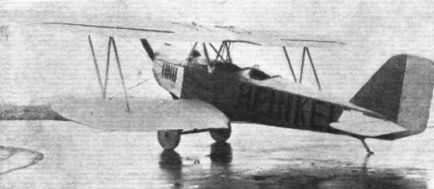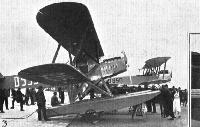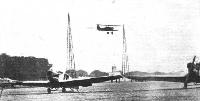
HD.21/22/24/32/35/36
Самолет HD 21 - первый поднявшийся в воздух биплан компании "Heinkel", это произошло в 1924 году. На машине стоял мотор Mercedes мощностью 120 л. с. (89 кВт). Кроме того, HD 21 стал первым в серии двух-/трехместных спортивных и учебно-тренировочных самолетов основной подготовки летчиков. Несколько меньший по размерам, но конструктивно похожий, вариант HD 29 выполнил первый полет в 1925 году, на нем предусматривалась возможность размещения третьего члена экипажа, и был установлен мотор Siemens мощностью 100 л. с. (75 кВт). Таким же мотором оснастили и вариант HD 32, в конструкцию которого, однако, внесли ряд изменений. Удлиненный вариант HD 35 появился в конце 1929 года, он был несколько больше исходного HD 21 и оснащался 120-сильным (89 кВт) мотором Mercedes. Далее был спроектирован HD 36 с мотором Mercedes D.III мощностью 160 л. с. (119 кВт).
Самолеты Heinkel HD 22 и HD 24 в общем мало отличались друг от друга. Оба оснащались мотором BMW D7 мощностью 230 л.с. (172 КВТ). Размах крыльев спроектированного в 1926 году HD 22 составлял 12,00 м, длина самолета была 8,30 м; машина предназначалась для первоначального обучения летчиков. Больший по размерам HD 24 предназначался для обучения летчиков гидросамолетов и обладал хорошими летными качествами на малых скоростях. Строились также самолеты HD 24 с колесным шасси.
Описание:
- HD.21/22/24/32/35/36
- Flight, May 1925
THE ROUND-GERMANY FLIGHT - Flight, July 1926
THE GERMAN SEAPLANE COMPETITION - Flight, November 1928
BERLIN AERO SHOW 1928
Фотографии
-
Flight 1925-05 / Flight
The Heinkel H.D.21: Three-quarter rear view.
-
Air-Britain Archive 1986-02
Регистрационный номер: SE-ACY C.G.von Rosen's Heinkel ex SE-ACY painted in the Ethiopian colours of green/yellow/red in addition to the Red Cross markings.
-
Мировая Авиация 154
На основе самолета HD 21 компания "Heinkel" спроектировала самолет начальной подготовки летчиков HD 22. Часто вместо первоначального мотора BMW ставились другие двигатели близкой мощности.
-
Мировая Авиация 154
Регистрационный номер: D-1160 HD 24 выпускался одновременно в двух вариантах - и с колесным, и с поплавковым шасси. Одна машина была использована известным военным летчиком Гюнтером Плюшовым в германской исследовательской экспедиции в Патагонию, Южная Америка.
-
Flight 1926-07 / Flight
Регистрационный номер: D-935 HEINKELS AT WARNEMUNDE: Ernst Heinkel, one of the pioneers of German aircraft construction, is represented by five machines. 3 shows the two biplanes, type H.D.24, which are fitted with 230 h.p. B.M.W. IV engines.
Другие самолёты на фотографии: LFG V.60 - Германия - 1926
-
Air Enthusiast 1998-11 / L.Andersson - Heinkels for Sweden
Heinkel HD 24 (Sk 4) seaplane trainer 201, one of the two original Heinkel-built examples.
-
Flight 1925-06 / Flight
ROUND-GERMANY COMPETITION: The Heinkel H.D.32 biplane, fitted with Bristol "Lucifer'' engine, covered the total distance of 5,242 kms.
-
Мировая Авиация 154
Самолет HD 32 является развитием учебного HD 21. Одна машина с мотором Bristol Lucifer построена в 1925 году.
-
Flight 1925-06 / Flight
A Heinkel biplane coming in after a test flight. The machines in the foreground are Junkers commercial monoplanes.
Другие самолёты на фотографии: Junkers F 13 - Германия - 1919
-
Air Enthusiast 1998-11 / L.Andersson - Heinkels for Sweden
The Heinkel HD 35 trainer was delivered to Flygkompaniet as a prototype in 1926.
-
Мировая Авиация 154
Регистрационный номер: D-HD36 Самолет HD 36 проектировался по заказу ВВС Швеции. Компания CFM построила по лицензии 20 самолетов, обозначавшихся как Sk 6.
-
Air Enthusiast 1998-11 / L.Andersson - Heinkels for Sweden
Although looking rather smashed up, this Heinkel HD.36 (Sk 6) was later repaired and returned into service with F 5 at Ljungbyhed.
-
Air-Britain Archive 1984-01
Регистрационный номер: D-1313 An earlier identity solved was that of "Condor de Plata" Heinkel HD24 D-1313 which crashed in Lake Rico, Argentina on 28.1.31. The name "Tsingtau" is clearly visible.
-
Flight 1928-11 / Flight
THE HEINKEL BIPLANE (H.D.22): On the left a general view of undercarriage, wing bracing, etc. The details on the right show attachment of inter-plane strut and anti-lift wires to lower wing spar.
-
Flight 1925-05 / Flight
Heinkel HD 21 School Machine
- Фотографии














